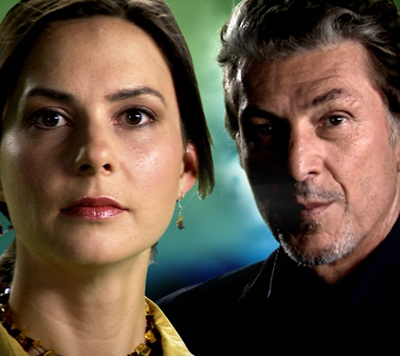
(RNS1-JAN28) Randall Sullivan and Indre Viskontas go on the hunt for the truth behind miracles in the new show “Miracle Detectives” on the Oprah Winfrey Network. For use with RNS-MIRACLES-SHOW, transmitted Jan. 28, 2011. RNS photo courtesy Windfall Management.
(RNS) Dirt at an ancient holy site in Chimayo, N.M. reputedly cures a woman’s rare bone cancer.
In North Carolina, a 14-year-old girl stricken with pneumonia is removed from life support but survives after an angelic image appears on a security monitor outside her hospital room.
A Texas man lives despite being cut in half after being run over by a train.
Were these acts of God, or is there a scientific explanation for events that seem to defy reason?
For an hour every Wednesday night (10 p.m. EST), that divisive question is the focus of “Miracle Detectives,” one of prime-time television’s first forays into exploring the miraculous.
The show features two investigators — one a believer, the other a scientist — who seek answers to “mysterious incidents that seem to transcend logic.” It’s one of 17 programs on the new Oprah Winfrey Network (OWN), which debuted New Year’s Day.
In a society less devout than the United States, and in an era of near daily scientific breakthroughs, such a show might seem a waste of valuable air time. But polls in the U.S. consistently show that 80 percent of Americans believe miracles occur, and slightly more than half believe in guardian angels.
“Miracle Detectives” may be preaching to the converted: An OWN online survey found that more than 92 percent of those watching the program said they believe in miracles; nearly 3 percent said they do not; and almost 5 percent said they “need proof.”
Each week, hosts Randall Sullivan, who says he experienced a miracle himself, and Indre Viskontas, a neuroscientist who sings in her church choir but approaches the supernatural with skepticism, visit the sites of reported miracles to hear first-hand accounts.
Interviewing experts and conducting experiments, the duo gathers information and attempts to answer the question: Miracle, or not?
Sullivan, 59, said there is no conflict being an evidence-hungry reporter while also believing in supernatural signs and wonders.
“A journalist’s role is to explore,” he said. “Yes, you’re certainly seeking truth, but you’re also exploring. First thing I want to know is, what happened to people? What did they experience? I want it from the inside out, from them and from me.”
Viskontas, 34, holds a doctorate in cognitive neuroscience, but also calls herself “a very spiritual person,” who was raised a Roman Catholic and is a soloist in her church choir. `
“I identify as a scientist,” she says. “A scientist is interested in trying to understand the phenomenon in front of them. They’re trying to get at what is actually happening.”
An expert in how memories are formed and retrieved, Viskontas says she’s in a unique position to discover what someone remembers, what actually happened, and how circumstances led them to believe there is a supernatural force at work.
That doesn’t mean she denies the possibility of the miraculous. In fact, she struggles with it.
“One of things I struggle with the most is the idea that an all-loving, all-powerful, all-knowing God would choose to use miracles in which to operate,” says Viskontas.
`There are so many instances in which those miracles don’t happen. It’s very hard for me to believe that God would act in such a direct way, and it seems to me if that were true, then he’s kind of an underachiever,” she said.
Sullivan had a life-altering experience while covering the war in Bosnia in the 1990s for Rolling Stone magazine. Raised in an irreligious family, he found himself “skeptical and guarded” in the village of Medjugorje, where visions of the Virgin Mary have been reported, drawing pilgrims by the busload.
“I was there to observe, not to be a pilgrim,” he recalls.
While climbing the Mountain of the Cross, the central feature in the village, Sullivan was caught up a violent thunderstorm and feared he might die. He encountered a group of nuns, singing in French and kneeling in prayer.
“For the very first time in my life I got down on my knees in the mud and stone and prayed with them and felt an immense sense of release and uplift,” he recalled. “It was like a cork had been pulled out of a bottle.”
A young woman draped a cloth on his shivering shoulders. “I felt instantly warmed and comforted. But when I opened my eyes, the nuns and the woman were gone.”
No one else had seen or heard the nuns, Sullivan said. “The only thing that made me feel I wasn’t completely insane was that I still had the cloth in my hand.”
After struggling with the experience, Sullivan decided to embrace it and concluded that it had been a gift from God.
“That core belief inside is so deeply set that I really do believe there are miracles, and I approach most of these cases (on the program) wanting to believe,” he said.
“But I’m certainly willing to check it out. If it’s true, there’s nothing to be lost challenging it.”




